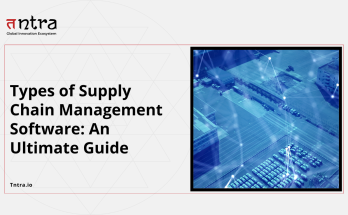Supply chain management undergoes a digital transformation that integrates modern technology with redesigned operations to improve visibility, automate procedures, and encourage creativity. Real-time supplier performance data, enhanced customer experiences, and substantial cost savings through process optimization are some of the main advantages. Automation facilitates smooth collaboration, increases production, and decreases manual labor. Furthermore, data is used by advanced analytics to find inefficiencies and improve decision-making. Businesses may create new value and improve supply chain security, traceability, and agility in response to new problems as they adjust to this digital reality. Continue reading to learn more:
Walmart is investing heavily in infrastructure and supply chain digitalization as part of its digital transformation. The effective supply chain that exists today is a result of these efforts. 72% of Walmart’s strategic capital expenditures in 2019 and 2020 were allocated to supply chain transformation, encompassing e-commerce, infrastructure, and supply chain technologies. The corporation spent almost $11 billion during this time.
Faster, more adaptable fulfillment as well as more precise demand forecasts are the outcomes of these expenditures. Walmart’s effort to cut down on packaging waste also makes use of technology. By precisely collecting product dimensions and other information, packaging algorithms facilitate the process of identifying the ideal packaging for every product.
Furthermore, Walmart’s distribution centers are equipped with an innovative warehouse management system (WMS). Better labor planning and inventory control are made possible by this more sophisticated WMS, which helps to optimize supply chain processes as a part of its digital transformation strategy.
All in all, automation is one of their biggest technology investments. Pallets are moved by autonomous mobile robots to assist warehouse workers; other automation technologies are used for choosing things and packaging them into containers. Additionally, Walmart has invested heavily in sorting machinery that mechanically sorts goods and assigns them to the appropriate areas of the warehouse. Sturdy warehouse control systems facilitate the connection between the WMS and these automation devices.
(Source: ShipBob)
Digital Disruptions in Supply Chain
In terms of manufacturing, supply chain, engineering, and product development, 85% of executives have implemented or plan to implement AI.
Merely 33% of small enterprises either utilize inventory management software or conduct inventory straight within Quickbooks, their accounting software. It’s crucial to remember that 24% of small firms lack inventories.
By 2025, Robotics integration as digital transformation in supply chain management is anticipated to grow at a rate of 14% per annum.
How Digital Transformation Elevates Supply Chain Management
Redesigned operations are combined with appropriate state-of-the-art technologies in the proper supply chain digitisation strategy. The fundamentals of the transformation strategy, which include creating a roadmap for the transformation, evaluating the supply chain’s present condition, and creating a vision for the future, will be known to many managers. Some new elements of this strategy apply to supply chain digital transformation. A combination of no-regrets improvements and more ambitious, long-term reforms will be required to achieve the aim.
Here’s how digital transformation can improve supply chain outcomes:
- Enhanced supply chain visibility
Digital supply chain solutions offer much greater visibility into its components and moving parts than traditional supply chains do. Businesses can see supplier performance in real time, which enables them to spot any gaps that could lead to interruptions and fix them. Additionally, because digital supply chains put the requirements of the consumer first, businesses are better able to comprehend their demands and take steps to enhance their customers’ experiences. - Automating complex processes
The manual, paper-based supply chain procedures are replaced by a digital supply chain using software product engineering services. It does away with the requirement for stakeholders to call or email requests for updates and eliminates the necessity for manual data entry. To enhance their operations and work together with other organizations, anyone who requires it can easily access all the necessary information. Business process automation brought forth by digitalisation enhances worker productivity, performance, and profitability in addition to process efficiency. Throughout the whole supply chain, real-time inventory tracking is made possible by digital technologies like sensors. In the end, electronic connectivity helps businesses to redefine new business strategies and optimize the supply chain. - Low costs and high innovation
Current, comprehensive information about performance, condition, and requirements is provided by digital transformation services. Processes including the flow of raw materials, operational logistics, inventory levels, forecasting, and resource planning may all be managed and optimized with the use of this information. These are the immediate results of increased cash flow and expense savings. Collaboration and information sharing that is better allows for the identification of process bottlenecks, shorter time-to-market, faster invention, and higher return on innovation. - Advanced analytics for insights
Numerous data-driven technologies, such as big data, machine learning, IoT, and predictive analytics, enable the digital supply chain. Data sources can be linked and related by organizations to enhance preventive maintenance and inventory management. Businesses can use data to find inefficiencies, improve the quality of their products, and improve client interactions. Advanced analytics that visualize data and help users learn from mistakes, make predictions, and make better decisions can also be obtained through a digital supply chain.
The Bottom Line
Numerous crises have served as a reminder of the supply chain’s strategic importance. The three most important concepts are security, traceability, and agility. Therefore, digitalizing procurement and automating and digitizing the supply chain, as well as potentially other company operations, offer a completely new avenue for value generation. Even though the great majority of businesses were the ones to start this digital transformation, in order to fully benefit from it, they still need to adjust to this new environment.
Tntra’s experts in digitizing supply chain management understand what it takes to achieve efficient outcomes. As a software product engineering company, we have helped over 50 clients achieve successful transformations for their business.
Want to kickstart digital transformation? Schedule a call today.



